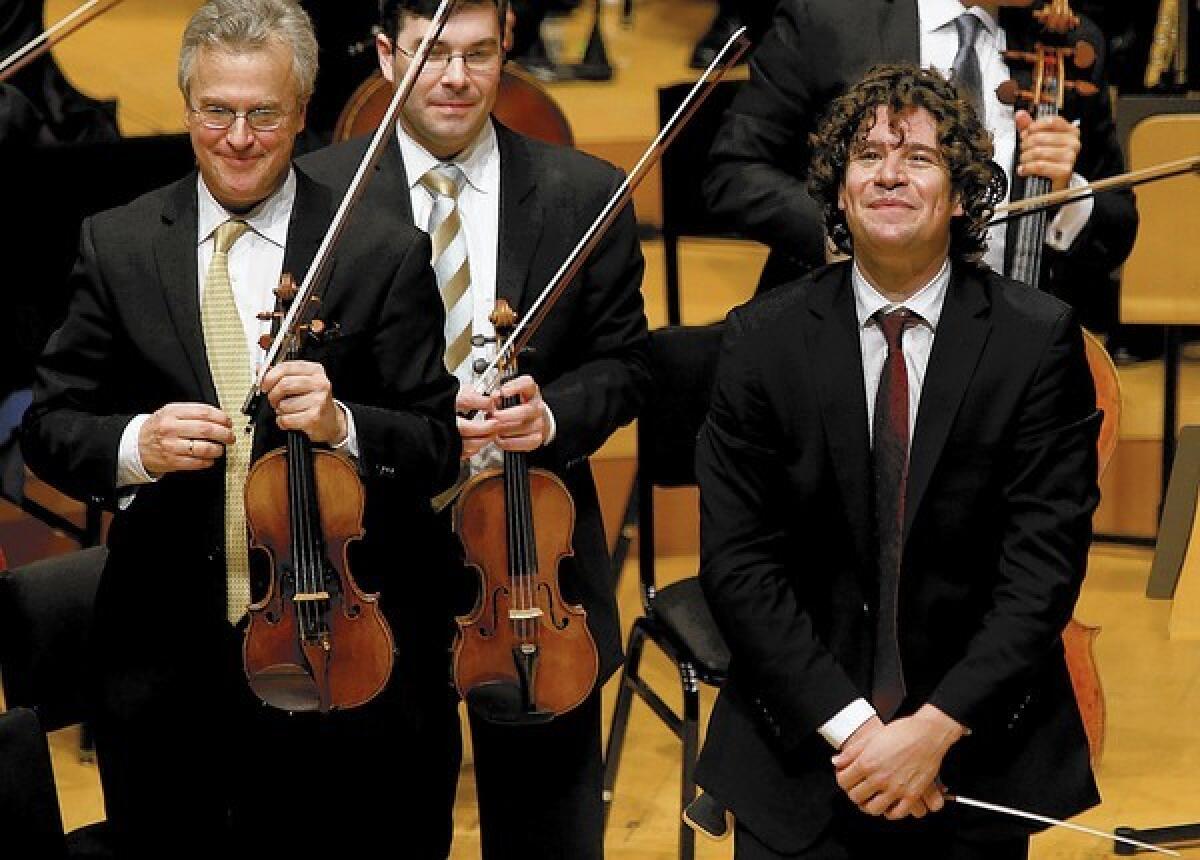Review: Emanuel Ax’s ‘Brahms Project’ in good hands

- Share via
When you see “Project” following the name of a classical composer or composition, something modern this way likely comes. Thus, the “Brahms Project” that pianist Emanuel Ax launched with the Los Angeles Philharmonic over the weekend at Walt Disney Concert Hall will, during the next couple of months, position Brahms with, among others, a young, Brooklyn-based composer.
In an interview with The Times, Ax pointed out that our image of Brahms is not as a beautiful young man, not a composer like you’ll find in the youth music scene in places like Brooklyn these days. In fact, you rarely hear the phrase young Brahms, only early Brahms, as if he were always psychically that somber, pot-bellied old man of the familiar likenesses. The concertos and symphonies and most popular chamber and solo works, moreover, tend to be his mature works.
He was always heavy. The First Piano Concerto — an exception for a Brahms blockbuster having been written when Brahms was in his early 20s — is big of bone. It is in the stormy, melancholic key of D-Minor. It makes a mighty sound and demands a muscular pianist. A fast performance is at least 45 minutes.
PHOTOS: Arts and culture in pictures by The Times
Yet the D-Minor Concerto is also not just early but genuinely youthful if performers are willing to let it be. The legendary pianist Arthur Rubinstein brought out that quality in the score, and so did Ax on Saturday. He also had help from a young conductor, Robin Ticciati.
The 30-year-old Brit is moving up the maestro ranks quickly. Principal conductor of the Scottish Chamber Orchestra, Ticciati begins this month as music director of Britain’s Glyndebourne Festival, a major appointment. A video of his conducting of Benjamin Britten’s “Peter Grimes” at La Scala in 2012 confirms the raves the production received. But here’s a spoiler: It’s time to remove the qualification in his official bio of “unanimous critical acclaim” for his soft-edged Berlioz recordings.
Ticciati has also been uneven in his appearances with the L.A. Phil. But this time he definitely had youth (and Ax) on his side. The Brahms concerto was saved until after intermission. The way was prepared with Schumann’s also youthful First Symphony and with György Ligeti’s “Melodien.”
“Melodien” was the program’s nod to Modernism, and the 1971 atmospheric score has had a curious history here. The L.A. Phil, under Zubin Mehta, first performed it four months after its German premiere. Ligeti had become a celebrity a few years earlier because his space-age music was used in “2001: A Space Odyssey.” Hollywood consequently came out for “Melodien,” which was a transitional work toward Ligeti’s more Minimalist, mechanical and melody-based later music.
CRITICS’ PICKS: What to watch, where to go, what to eat
The often hard-to-please Hungarian composer refused, however, to take a bow, Mehta has said, because four rehearsals weren’t enough for him, and maybe the applause wasn’t either. In 1997, Esa-Pekka Salonen conducted a sizzling version of the work that did create a buzz.
Ticciati went in a direction different than either Mehta or Salonen and made “Melodien” seem almost delicately Brahmsian with its thick harmonic clouds and seldom synchronized rhythms. Melodies are hinted at but not shaped. Brahms did something like that too in his late music. The L.A. Phil played with confident flair, with an intricately gauged sense of color.
Ticciati’s Schumann had similar traits. It was light and propulsive. A dotted rhythm that pervades the first movement did more than pervade — it all but regulated everything.
The Brahms concerto necessarily received more weight. The big symphonic opening was transparent, grand and a little contrived, with much emphasis given to the timpani attack that starts the concerto in motion.
Waiting for his entrance, Ax put his attention on the orchestra. He faced the musicians and looked to be communing with them. He then brought an ingratiating luminosity to his first solo passage that gave the remarkable impression of the piano somehow growing out of the decay of the timpani.
RELATED: Faces to watch 2014 | Classical music
There is no more genial-seeming pianist than Ax. He has an opulent tone and an unerring sense of lyricism. He makes difficult passages seem utterly normal. His performances are of a pianist at one with the music.
And so he was on the surface Saturday. But what made Ax’s playing particularly striking was that he didn’t go too deep. Rather, he found exactly the right tricky depth, and in doing so he slyly made sure the orchestra did as well.
He further reminded us of a young Brahms, a fabulous virtuoso pianist full of originality, overfull of great melodies and in the process of developing a harmonic language that began to move music in Ligeti’s direction. Brahms is sometimes placed on the wrong side of music history, a traditionalist and not, like Wagner, the composer of the future.
Schoenberg believed otherwise. Ax’s “Brahms Project” is headed in the right direction.
More to Read
The biggest entertainment stories
Get our big stories about Hollywood, film, television, music, arts, culture and more right in your inbox as soon as they publish.
You may occasionally receive promotional content from the Los Angeles Times.











